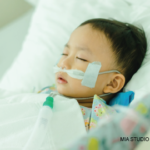Thinking Big
Why do patients develop Kawasaki’s disease? The answer, my friends, is blowing in the wind. We think.
For 50 years following the initial description of Kawasaki’s disease, episodic epidemics have been identified in Japan, the U.S. and elsewhere. The mystery has been why these epidemics emerge at a specific time and place.
The three largest epidemics of Kawasaki’s disease occurred in Japan in April 1979, May 1982 and March 1986. Investigators from the U.S. and Japan analyzed environmental factors, such as sea level pressure and surface winds, in the months preceding each epidemic.8
The investigators learned that each epidemic was preceded by a shift in the direction of the wind. Typically, in the months associated with a low incidence of Kawasaki’s disease, the winds over Japan come from the south or the northeast. When the origin of the wind changes to Central Asia, blowing over Japan from the northwest side of the island, rates of Kawasaki’s disease start to spike. Some data indicate the same winds from Central Asia, blowing across the Pacific, may be responsible for peaks in the incidence of Kawasaki’s disease in San Diego.
What is in the air from the steppes of Central Asia that is causing children to develop Kawasaki’s disease? It could be, quite literally, anything—multiple organisms could survive airborne in the long trip from Asia to Southern California, and no one knows if the etiologic agent is a single pathogen. Dr. Yeung hypothesizes it may be a class of organisms or molecules, all of which induce the same pathologic response in the right host.3
Who is the right host? Genetically, humans are 99.9% alike. The risk of developing Kawasaki’s disease likely lies in that crucial 0.1% difference. One method of determining what genetic difference may confer an increased risk is to look at single-nucleotide polymorphisms, or SNPs. There are 10 million polymorphic SNPs in the human genome, meaning that, at 10 million points in your DNA, you may have an adenine, while the person reading this article over your shoulder may have a guanine or another nucleotide.9
This is a little different than Mendelian genetics. Any individual SNP is unlikely to create a problem. It is likely a specific combination of SNPs that places an individual at risk. Determining which specific SNPs are associated with a given diagnosis may lead to additional insights into the genes that are important to disease pathogenesis.
How do we find these SNPs? A genome-wide association study (GWAS) is based on the hypothesis that if a genetic variant is associated with a given illness, then that variant should be more common among patients with the disease than in patients without. Interestingly, the GWAS approach itself is hypothesis free: You don’t have to know what you are looking for. You just look. Unburdened by hypotheses, this approach is less likely to be flawed by our own preconceived notions of what we should find.
In the days of Sanger sequencing, a GWAS would have been impossible. With advances in technology bringing down the cost and labor associated with genotyping, genome-wide association studies have been used to identify genetic variants associated with bipolar disorder, coronary artery disease, hypertension, Crohn’s disease, rheumatoid arthritis, diabetes and many other diseases—including Kawasaki’s.
In 2009, the International Kawasaki Disease Genetics Consortium conducted a GWAS in 893 patients with Kawasaki’s disease. This study identified a single functional network of five genes involved with inflammation, apoptosis and cardiovascular pathology.10 This network may provide new treatment targets, but longer term, may also explain why some children are so sensitive to winds from the central steppes.
The story of Kawasaki’s disease is the story of thinking big. The work on environmental factors associated with Kawasaki’s disease involved investigators from four institutions on three continents. The work of the International Kawasaki Disease Genetics Consortium includes investigators from Australia, The Netherlands, Singapore, the United Kingdom and the U.S. Together, these investigators—looking at large datasets representing large groups of patients with a rare disease—are making observations and advances that would have been out of reach for any single institution.
At the same time, however, I hope we don’t lose sight of the fact that all of this was dependent on individuals thinking small. It was one physician, fascinated by a single case of a single child, who was discharged a few days after he met him, that led to the first descriptions of Kawasaki’s disease. Another physician, similarly entranced by a single case, connected Kawasaki’s disease to the presence of coronary arteritis.
Big data would never identify such outliers. They would be excluded from the initial analysis because they did not meet study criteria. Or they would end up being represented by a single dot, well past the 75th percentile in the box plot, likely without further comment. Large consortiums of investigators and patients clearly bring new potential for new insights, but I hope we do not lose sight of the importance of the single observation to discovery. Rheumatology is just now starting to think big, and we are all the better for it, but at the same time, I hope we don’t forget how to think small.


